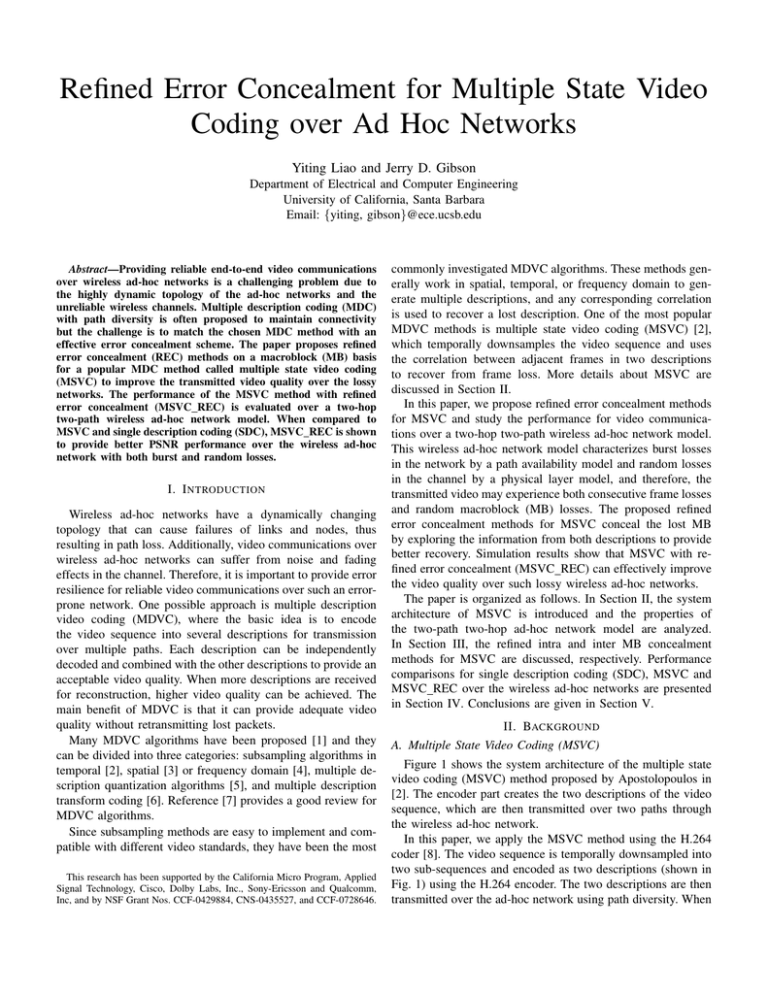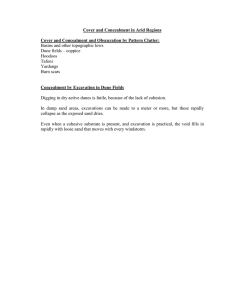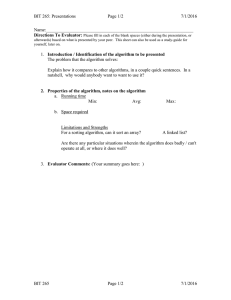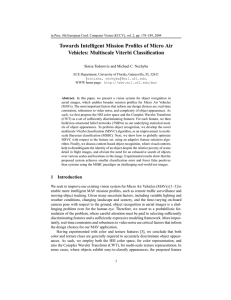Refined Error Concealment for Multiple State Video
advertisement

Refined Error Concealment for Multiple State Video
Coding over Ad Hoc Networks
Yiting Liao and Jerry D. Gibson
Department of Electrical and Computer Engineering
University of California, Santa Barbara
Email: {yiting, gibson}@ece.ucsb.edu
Abstract—Providing reliable end-to-end video communications
over wireless ad-hoc networks is a challenging problem due to
the highly dynamic topology of the ad-hoc networks and the
unreliable wireless channels. Multiple description coding (MDC)
with path diversity is often proposed to maintain connectivity
but the challenge is to match the chosen MDC method with an
effective error concealment scheme. The paper proposes refined
error concealment (REC) methods on a macroblock (MB) basis
for a popular MDC method called multiple state video coding
(MSVC) to improve the transmitted video quality over the lossy
networks. The performance of the MSVC method with refined
error concealment (MSVC REC) is evaluated over a two-hop
two-path wireless ad-hoc network model. When compared to
MSVC and single description coding (SDC), MSVC REC is shown
to provide better PSNR performance over the wireless ad-hoc
network with both burst and random losses.
I. I NTRODUCTION
Wireless ad-hoc networks have a dynamically changing
topology that can cause failures of links and nodes, thus
resulting in path loss. Additionally, video communications over
wireless ad-hoc networks can suffer from noise and fading
effects in the channel. Therefore, it is important to provide error
resilience for reliable video communications over such an errorprone network. One possible approach is multiple description
video coding (MDVC), where the basic idea is to encode
the video sequence into several descriptions for transmission
over multiple paths. Each description can be independently
decoded and combined with the other descriptions to provide an
acceptable video quality. When more descriptions are received
for reconstruction, higher video quality can be achieved. The
main benefit of MDVC is that it can provide adequate video
quality without retransmitting lost packets.
Many MDVC algorithms have been proposed [1] and they
can be divided into three categories: subsampling algorithms in
temporal [2], spatial [3] or frequency domain [4], multiple description quantization algorithms [5], and multiple description
transform coding [6]. Reference [7] provides a good review for
MDVC algorithms.
Since subsampling methods are easy to implement and compatible with different video standards, they have been the most
This research has been supported by the California Micro Program, Applied
Signal Technology, Cisco, Dolby Labs, Inc., Sony-Ericsson and Qualcomm,
Inc, and by NSF Grant Nos. CCF-0429884, CNS-0435527, and CCF-0728646.
commonly investigated MDVC algorithms. These methods generally work in spatial, temporal, or frequency domain to generate multiple descriptions, and any corresponding correlation
is used to recover a lost description. One of the most popular
MDVC methods is multiple state video coding (MSVC) [2],
which temporally downsamples the video sequence and uses
the correlation between adjacent frames in two descriptions
to recover from frame loss. More details about MSVC are
discussed in Section II.
In this paper, we propose refined error concealment methods
for MSVC and study the performance for video communications over a two-hop two-path wireless ad-hoc network model.
This wireless ad-hoc network model characterizes burst losses
in the network by a path availability model and random losses
in the channel by a physical layer model, and therefore, the
transmitted video may experience both consecutive frame losses
and random macroblock (MB) losses. The proposed refined
error concealment methods for MSVC conceal the lost MB
by exploring the information from both descriptions to provide
better recovery. Simulation results show that MSVC with refined error concealment (MSVC REC) can effectively improve
the video quality over such lossy wireless ad-hoc networks.
The paper is organized as follows. In Section II, the system
architecture of MSVC is introduced and the properties of
the two-path two-hop ad-hoc network model are analyzed.
In Section III, the refined intra and inter MB concealment
methods for MSVC are discussed, respectively. Performance
comparisons for single description coding (SDC), MSVC and
MSVC REC over the wireless ad-hoc networks are presented
in Section IV. Conclusions are given in Section V.
II. BACKGROUND
A. Multiple State Video Coding (MSVC)
Figure 1 shows the system architecture of the multiple state
video coding (MSVC) method proposed by Apostolopoulos in
[2]. The encoder part creates the two descriptions of the video
sequence, which are then transmitted over two paths through
the wireless ad-hoc network.
In this paper, we apply the MSVC method using the H.264
coder [8]. The video sequence is temporally downsampled into
two sub-sequences and encoded as two descriptions (shown in
Fig. 1) using the H.264 encoder. The two descriptions are then
transmitted over the ad-hoc network using path diversity. When
Description 1: I1ĺP3ĺP5…In+1ĺPn+3ĺPn+5…
Video
Sequence
H.264 Encoder
with Multiple
Description
Generator
H.264
Decoder
ad-hoc networks
Description 2: I2ĺP4ĺP6…InĺPn+2ĺPn+4…
Fig. 1.
D1
D0
H.264
Decoder
D2
MSVC system architecture
both descriptions are successfully received at the decoder, they
can be decoded and interleaved for display. If one description
suffers severe losses, the other description can still be decoded
independently and used to conceal the lost description. Due
to the decreased correlation between adjacent frames, the
total bitrate is increased by MSVC for equivalent error-free
performance.
B. Two-hop Two-path Ad-hoc Network Model
Because of the dynamic topology of wireless ad-hoc networks, the paths in the network may fail and cause burst losses.
Also, there are random bit errors due to noise and fading in the
physical channel. A two-hop two-path ad-hoc network model
in [9], which consists of a path availability model [10] and a
physical layer model [11], is used to capture the packet loss
features of wireless ad-hoc networks.
1) Path Availability Model [10]: The path availability model
characterizes the burst losses in the network caused by route
changes, node mobility, etc. The model assumes that there are
N+2 nodes in the area as shown in Fig. 2. Two nodes represent
the sender and receiver nodes while the other N nodes, which
move randomly in the area, can serve as the router nodes. In
this model, a two-hop scenario is used, i.e. a path between the
sender and receiver nodes is set up when one of the N nodes can
serve as the router node. The path may become unavailable due
to node movement and route switching delay. The average path
unavailability time depends on many factors such as number
of nodes in the network, distance between sender and receiver
nodes, node velocity, and transmission range. According to [9],
we know that the path down time is on the order of seconds,
which may cause long burst packet losses. We will see later
that MSVC is an effective method to combat burst losses in
the network.
2) Physical Channel Model: When the path is set up for
transmission, we need to consider bit errors due to the noise
and fading in the physical channel, and the Gilbert Elliot model
[11] is used to simulate this random loss. In this model, the
channel transits between the good state (low bit error rate) and
the bad state (high bit error rate) with certain transition rates.
Any bit error in a packet will cause packet loss. Therefore, the
packet loss rate is higher for a larger payload size.
III. MSVC
which means each frame consists of more than one packet.
Therefore, a packet loss only causes some MB losses in a
frame. In [2], it is assumed that every packet loss leads to one
entire frame loss and the state recovery methods introduced
are on a frame basis. In this paper, we propose the refined
error concealment methods on a MB basis to enhance the
reconstructed video quality for MSVC. We refer to the approach
as multiple state video coding with refined error concealment
(MSVC REC).
In general, the existing error concealment methods exploit
the correlation between a lost macroblock and its adjacent
MBs in the spatial or temporal domain. In H.264, some nonnormative error concealment methods are introduced to conceal
the lost MBs. The lost MB in an intra frame is concealed
by weighted pixel interpolation while the lost MB in an inter
frame is recovered by motion-compensated concealment using
the estimated motion vectors.
A. Refined Intra MB concealment for MSVC
In H.264, the lost MB in an intra frame is concealed spatially
based on weighted pixel interpolation. Each pixel in the lost MB
is estimated from the weighted sum of the boundary pixels in
the adjacent MBs. If two or more correctly received neighboring MBs are available, only they are used for concealment.
Otherwise, concealed MBs are also used for the interpolation.
The lost MB in an intra frame is only concealed spatially in
order to stop the error propagation from the previous group
of picture (GOP). For MSVC, each description has an intra
frame in every GOP and the two intra frames are consecutive
as shown in Fig. 1. Therefore, we can apply both temporal and
spatial concealment for the lost MB in the two consecutive intra
frames.
The process to conceal lost MBs in the two consecutive intra
frames is shown in Fig. 3. The lost MB in the intra frame is
concealed by either copying the MB from the corresponding
position in the other intra frame or applying weighted pixel
interpolation. If both intra frames have some lost MBs in the
same position, these lost MBs are concealed by weighted pixel
interpolation. Otherwise, we copy the MB in the corresponding
position in the other intra frame and calculate the side match
distortion [13] from the correctly received neighbour MBs.
If the side match distortion is smaller than the pre-defined
WITH REFINED ERROR CONCEALMENT
When video is transmitted over wireless networks, a typical
maximum transfer unit (MTU) size is around 100 bytes [12],
Fig. 2.
Two-hop ad-hoc network, S: Sender, R: Receiver [9]
Decode the correctly received MBs in In
and In+1 , and generate the MB status map
In+1
In
Motion-compensated
concealment
MVtop MVzero
Reference Frame List
MVleft
Conceal the MBs that are lost at the
same spatial position in both frames by
weighted pixel interpolation
For other lost MBs, copy the MBs from the
same position of the other intra frame and
calculate the side match distortion Ds
Ds < threshold
Frame n-5
Frame n-1
MVbottom
Lost MB
Frame n+1
(a) Inter MB concealment in H.264
Reference Frame List 1
No
Yes
Conceal by temporal copy
Frame n-3
MVright
Frame n-5
Frame n-3
Frame n-1
MVtop MVzero
Conceal by weighed pixel interpolation
MVleft
Fig. 3.
MVright
Error concealment in intra frame for MSVC
MVbottom
Frame n-4
threshold, the temporal copy concealment is applied to conceal
the lost MB. If not, the weighted pixel interpolation is used to
conceal the lost MB.
B. Refined Inter MB concealment for MSVC
In [13], the lost inter MB is concealed by estimating the
lost motion vector from the neighbour MBs and applying
motion-compensated prediction. When an inter MB is lost, the
motion vector of the missing MB is predicted from one of
the neighbour MBs or zero motion vector as shown in Fig.
4(a). The motion vector that has the minimum side match
distortion is used for motion-compensated concealment. The
reference frames used to conceal the lost MB are the same as
the reference frames for correctly received MBs.
For MSVC, we can explore the information from both descriptions to enhance the inter error concealment, that is, we use
two reference frame lists from each description respectively for
the motion-compensated concealment. The reference list that
results in better side match distortion is used as the reference to
recover the lost MBs. As shown in Fig. 4(b), we add reference
frame list 2 from the other description. Since the estimated
motion vector is corresponding to the reference frames in list
1, we need to scale it accordingly when reference frame list 2
is used. The same motion-compensated concealment is applied
for reference frame list 2. Finally, we choose the estimated
motion vector and reference list that minimizes the side match
distortion to conceal the lost inter MB.
IV. P ERFORMANCE COMPARISON
A. Simulation Settings
In the simulation, we compare MSVC REC to SDC and
MSVC. Two QCIF (176 × 144) video sequences, Foreman and
Coastguard, with 120 frames are encoded for SDC, MSVC,
and MSVC REC using baseline profile in JM13.2 [14] with
RTP packet size 100 bytes. The GOP for each description is
40 and the total bitrate is set to be 150 kbps. Random intra
refresh, which randomly encodes some MBs in intra mode, is
introduced to enhance the error robustness of SDC. For MSVC,
Frame n-2
Frame n
Frame n+1
Reference Frame List 2
(b) Refined inter MB concealment for MSVC
Fig. 4.
Inter MB concealment methods
the state recovery method is applied on a frame basis, which
means the lost frame is estimated by performing a motioncompensated interpolation from the correctly received frames
in the other description. The refined error concealment methods
proposed in Section III are implemented for MSVC REC.
The two-hop two-path ad-hoc network model introduced in
Section II-B is used to generate the error pattern. The plotted
PSNR is averaged over 300 realizations for each error pattern.
We investigate the effect of both burst losses due to path
unavailability and random loss caused by bit errors in physical
channel.
B. Simulation Results
In Fig. 5, the burst loss rate in the ad-hoc networks is fixed
at 5.72% and the PSNR performance under different random
loss rates is shown. Fig. 5(a) shows that, for the Foreman
sequence, MSVC achieves a higher PSNR than SDC when
the random loss rate is 1% and has a lower PSNR than
SDC as the random loss rate increases. One reason is that
SDC uses random intra refresh to enhance its error robust
to random packet loss. In addition, the correlation between
adjacent frames within a description for MSVC is lower than
SDC, so the motion-compensated concealment for the original
MSVC does not conceal the random lost MBs as well as
SDC. In Fig. 5(a), we also see that the MSVC REC method
we propose outperforms MSVC in the range of 1.05 dB-2.64
dB and has a higher PSNR at around 1.8 dB than SDC.
This is because with the refined error concealment methods,
MSVC REC better exploits the correctly received information
from both descriptions to conceal the random lost MBs and
thus alleviates error propagation.
Similar results can be seen for the Coastguard sequence in
Foreman sequence, Burst Loss Rate = 5.72%
Foreman sequence, Random Loss Rate = 1%
36
35
SDC
MSVC
MSVCREC
34
34
33.5
PSNR (dB)
32
PSNR (dB)
SDC
MSVC
MSVCREC
34.5
30
28
33
32.5
32
31.5
31
26
30.5
24
0
2
4
6
8
30
10
0
2
4
Random Packet Loss Rate (%)
(a) Foreman sequence
8
10
12
(a) Foreman sequence
Coastguard sequence, Burst Loss Rate = 5.72%
Coastguard sequence, Random Loss Rate = 1%
31
30.5
SDC
MSVC
MSVCREC
30
SDC
MSVC
MSVCREC
30
29.5
PSNR (dB)
29
PSNR (dB)
6
Burst Loss rate (%)
28
27
29
28.5
28
26
27.5
25
24
27
0
2
4
6
8
10
26.5
0
Random Packet Loss Rate (%)
PSNR performance in terms of random packet loss rate
Fig. 5(b). The performance improvement for MSVC REC is
within the range of 0.4 dB-1.2 dB when compared to MSVC,
and between 0.2 dB-1.0 dB when compared to SDC. Note that
Coastguard sequence has higher motion than Foreman sequence
and the temporal copy method may not perform well for high
motion MBs.
Figure 6 investigates the PSNR performance for SDC,
MSVC, and MSVC REC under different burst loss rates. The
random loss rate in the physical channel is fixed at 1% and
the burst loss rate varies when the number of nodes in the
ad-hoc network changes. We notice that performance of SDC
drops greatly as the burst loss rate increases, which means SDC
is vulnerable to long burst losses. On the other hand, PSNR
of both MSVC and MSVC REC drop slowly when the burst
loss rate increases. We know that even if one description for
MSVC is totally lost, the other description can still be correctly
decoded and used to recover the lost description. The results
4
6
8
10
12
Burst Loss rate (%)
(b) Coastguard sequence
Fig. 5.
2
(b) Coastguard sequence
Fig. 6.
PSNR performance in terms of burst loss rate
shown in Fig. 6 prove that MSVC and MSVC REC are more
effective to combat burst losses than SDC. Also, MSVC REC
has higher PSNR than MSVC at about 1 dB for the Foreman
sequence, and at about 0.4 dB for Coastguard sequence.
In Fig. 5 and Fig. 6, we see that MSVC REC has better performance than SDC and MSVC under different combinations
of burst loss rates and random loss rates. The performance gain
for MSVC REC compared to MSVC increases when random
loss rate increases and a better gain is achieved for MSVC REC
compared to SDC when burst loss rate increases.
V. C ONCLUSIONS
In this paper, we have proposed refined error concealment
methods for MSVC based on H.264 to improve the error
resilience for video communications over wireless ad-hoc
networks. The refined intra MB concealment provides better
concealment for the MBs in intra frames by using the temporal
correlation between adjacent intra frames in two descriptions.
The refined inter MB concealment achieves improvement from
the additional reference list used for motion-compensated concealment. Compared to SDC and the original MSVC, the
MSVC REC method is shown to obtain performance gains over
the wireless ad-hoc networks for a wide range of different burst
loss rates and random loss rates.
R EFERENCES
[1] V. Goyal, “Multiple description coding: Compression meets the network,”
IEEE Signal Processing Mag., vol. 18, pp. 74–93, Sep. 2001.
[2] J. Apostolopoulos, “Reliable video communication over lossy packet
networks using multiple state encoding and path diversity,” Visual Communications and Image Processing, vol. 1, 2001.
[3] N. Franchi, M. Fumagalli, R. Lancini, and S. Tubaro, “Multiple description video coding for scalable and robust transmission over IP,” Circuits
and Systems for Video Technology, IEEE Transactions on, vol. 15, no. 3,
pp. 321–334, 2005.
[4] A. Reibman, H. Jafarkhani, Y. Wang, and M. Orchard, “Multiple description video using rate-distortion splitting,” Proceedings of IEEE
International Conference on Image Processing (ICIP01), vol. 1, pp. 978–
981, 2001.
[5] V. Vaishampayan, “Design of multiple description scalar quantizers,”
Information Theory, IEEE Transactions on, vol. 39, no. 3, pp. 821–834,
1993.
[6] Y. Wang, M. Orchard, V. Vaishampayan, and A. Reibman, “Multiple
description coding using pairwise correlating transforms,” Image Processing, IEEE Transactions on, vol. 10, no. 3, pp. 351–366, 2001.
[7] Y. Wang, A. R. Reibman, and S. Lin, “Multiple description coding for
video delivery,” Proceedings of the IEEE, vol. 93, pp. 57–70, 2005.
[8] T. Wiegand, G. J. Sullivan, G. Bjntegaard, and A. Luthra, “Overview of
the H.264/AVC video coding standard,” IEEE Trans. Circuits Syst. Video
Technol., vol. 13, pp. 560–576, Jul. 2003.
[9] J. Balam and J. D. Gibson, “Two-hop two-path voice communications
over a mobile ad-hoc network,” in IEEE GLOBECOM, 2007, pp. 2112–
2116.
[10] D. Trajanov, S. Filiposka, M. Efnuseva, and A. Grnarov, “Ad hoc
networks connection availability modeling,” Proceedings of the 1st ACM
international workshop on Performance evaluation of wireless ad hoc,
sensor, and ubiquitous networks, pp. 56–60, 2004.
[11] E. Gilbert, “Capacity of a burst noise channel,” Bell Syst. Tech. J., vol. 39,
pp. 1253–66., Sep. 1960.
[12] S. Wenger, “H.264/AVC over IP,” IEEE Trans. on Circuits and Systems
for Video Technology, vol. 13, pp. 645–656, Jul. 2003.
[13] V. Varsa, M. Hannuksela, and Y. Wang, “Non-normative error concealment algorithms,” ITU-T Doc, VCEG-N62, Sep. 2001.
[14] K. Suehring, G. Sullivan, and A. M. Tourapis, “JM 13.2 reference software.” [Online]. Available: http://iphome.hhi.de/suehring/tml/download/




